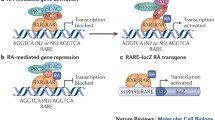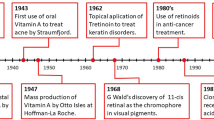Abstract
The vitamin A derivative retinoic acid (RA) and related compounds (retinoids) are utilized as signaling molecules in a diverse array of developmental and physiological regulatory processes, including many important in the developing and mature nervous system. Retinoids function by interaction with high affinity receptors of the nuclear receptor family, which also mediate the effects of steroid and thyroid hormones and which act in the nucleus as transcription factors. This review summarizes current knowledge of the molecular mechanisms of retinoid action, the complex role of retinoid receptors in a variety of hormonal signaling processes, and illustrates current efforts to more fully understand the biological functions of retinoid receptors through analysis of downstream gene regulatory networks and studies of mouse gene knockout systems.
Similar content being viewed by others
References
Agnish N. D., Vane F. M., Rusin G., DiNardo B., and Dashman T. (1990)Teratology 42, 25–33.
Akerblom I. E., Slater E. P., Beato M., Baxter J. D., and Mellon P. L. (1988)Science 241, 350–353.
Alles A. J. and Sulik K. K. (1990)Development 108, 73–81.
Blomhoff R., Green M. H., Berg T., and Norum K. R. (1990)Science 250, 399–404.
Blumberg B., personal communication.
Brockes J. P. (1990)J. Cell Sci. Suppl. 13, 191–198.
Buck J., Derguini F., Levi E., Nakanishi K., and Hammerling U. (1991)Science 254, 1654–1656.
Buck, J., Grun F., Derguini P., Chen Y., Kimura S., Noy N., et al. (1993)J. Exp. Med. 178, 675–680.
Castaigne S., Chomienne C., Daniel M. T., Ballerini P., Berger R., Fenaux P., et al. (1990)Blood 76, 1704–1709.
Cohlan S. Q. (1953)Science 117, 535–536.
Damm K. and Evans R. M. (1993)Proc. Natl. Acad. Sci. USA 90, 10,668–10,672.
de The H., Vivanco-Ruiz M. M., Tiollais P., Stunnenberg H., and Dejean A. (1990)Nature 343, 177–180.
Dolle P., Ruberte E., Leroy P., Morris-Kay G., and Chambon P. (1990)Development 110, 1133–1151.
Echelard Y., Epstein D. J., St-Jacques B., Shen L., Mohler J., McMahon J. A., et al. (1993)Cell 75, 1417–1430.
Evans R. M. (1988)Science 240, 889–895.
Fanjul A., Dawson M. I., Hobbs P., Jong L., Cameron J. F., Harlev E., et al. (1994)Nature 372, 107–110.
Flink I. L. and Morkin E. (1990)J. Biol. Chem. 265, 11,233–11,237.
Giuere V., personal communication.
Giguere V., Ong E. S., Segui P., and Evans R. M. (1997)Nature 330, 624–629.
Halioua B. and Saurat J. H. (1990)Br. J. Dermatol. 122 (Suppl. 36), 135–150.
Hartmann D. and Bollag W. (1993)J. Dermatol. 20, 674–678.
Heyman R. A., Mangelsdorf D. J., Dyck J. A., Stein R. B., Eichele G., Evans R. M., et al. (1992)Cell 68, 397–406.
Huang M. E., Ye Y. C., Chen S. R., Chai J. R., Lu J. X., Zhoa L., et al. (1988)Blood 72, 567–572.
Husmann M., Lehmann J., Hoffmann B., Hermann T., Tzukerman M., and Pfahl M. (1991)Mol. Cell. Biol. 11, 4097–4103.
Kalter H. and Warkany J. (1961)Am. J. Pathol. 38, 1–21.
Rastner P., Grondona J. M., Mark M., Gansmuller A., LeMur M., Decimo D., et al. (1994)Cell 78, 987–1003.
Kessel M. and Gruss P. (1991)Cell 67, 89–104.
Kirby M. L., Gale T. F., and Stewart D. E. (1983)Science 220, 1059–1061.
Kirby M. L. and Waldo K. L. (1990)Circulation 82, 332–340.
Kliewer S. A., Umesono K., Mangelsdorf D. J., and Evans R. M. (1992)Nature 355, 446–449.
Kliewer S. A., Umesono K., Noonan D. J., Heyman R. A., and Evans R. M. (1992)Nature 358, 771–774.
Kurokawa R., Yu V. C., Naar A., Kyakumoto S., Han Z., Silverman S., et al. (1993)Genes Dev. 7, 1423–1435.
LaMantia A. S., Colbert M. C., and Linney E. (1993)Neuron 10, 1035–1048.
Lamb A. J., Apiwatanaporn P., and Olson J. A. (1974)J. Nutr. 104, 1140–1148.
Lammer E. J., Chen D. T., Hoar R. M., Agnish N. D., Benke P. J., Braun J. T., et al. (1985)New Engl. J. Med. 313, 837–841.
Langston A. W. and Gudas L. J. (1992)Mech. Dev. 38, 217–227.
Lanotte M., Martin-Thouvenin V., Najman S., Balerini P., Valensi F., and Berger R. (1991)Blood 77, 1080–1086.
Laufer E., Nelson C. E., Johnson R. L., Morgan B. A., and Tabin C. (1994)Cell 79, 993–1003.
Lehmann J. M., Zhang X. K., and Pfahl M. (1992)Mol. Cell. Biol. 12, 2976–2985.
Leid M., Kastner P., and Chambon P. (1992)Trends Biochem. Sci. 17, 427–433.
Leid M., Kastner P., Lyons R., Nakshatri H., Saunders M., Zacharewski T., et al. (1992)Cell 68, 377–395.
Leroy P., Nakshatri H., and Chambon P. (1991)Proc. Natl. Acad. Sci. USA 88, 10,138–10,142.
Levin A. A., Sturzenbecker L. J., Kazmer S., Bosakowski T., Huselton C., Allenby G., et al. (1992)Nature 355, 359–361.
Li E., Sucov H. M., Lee K. F., Evans R. M., and Jaenisch R. (1993)Proc. Natl. Acad. Sci. USA 90, 1590–1594.
Lohnes D., Kastner P., Dierich A., Mark M., LeMeur M., and Chambon P. (1993)Cell 73, 643–658.
Lohnes D., Mark M., Mendelsohn C., Dolle P., Dierich A., Gorry P., et al. (1994)Development 120, 2723–2748.
Lufkin T., Lohnes D., Mark M., Dierich A., Gorry P., Gaub M. P., et al. (1993)Proc. Natl. Acad. Sci. USA 90, 7225–7229.
Maden M. (1993)Dev. Biol. 159, 379–391.
Mangelsdorf D. J., Borgmeyer U., Heyman R. A., Zhou J. Y., Ong E. S., Oro A. E., et al. (1992)Genes and Dev. 6, 329–344.
Mangelsdorf D. J., Kliewer S. A., Kakizuka A., Umesono K., and Evans R. M. (1993)Recent Progr. in Hormone Res. 48, 99–121.
Mangelsdorf D. J., Ong E. S., Dyck J. A., and Evans R. M. (1990)Nature 345, 224–229.
Mangelsdorf D. J., Umesono K., Kliewer S. A., Borgmeyer U., Ong E. S., and Evans R. M. (1991)Cell 66, 555–561.
Marks M. S., Hallenbeck P. L., Nagata T., Segars J. H., Appella E., Nikodem V. M., et al. (1992)EMBO J. 11, 1419–1435.
Marshall H., Nonchev S., Sham M. H., Muchamore I., Lumsden A., and Krumlauf R. (1992)Nature 360, 737–741.
Marshall H., Studer M., Popperl H., Aparicio S., Kuroiwa A., Brenner S., et al. (1994)Nature 370, 567–571.
McBurney M. W. (1993)Int. J. Dev. Biol. 37, 135–140.
Mendelsohn C., Lohnes D., Decimo D., Lufkin T., LeMeur M., Chambon P., et al. (1994)Development 120, 2749–2771.
Mendelsohn C., Mark M., Dolle P., Dierech A., Gaub M. P., Krust A., et al. (1994)Dev. Biol. 166, 246–258.
Mendelsohn C., Ruberte E., LeMeur M., Morriss-Kay G., and Chambon P. (1991)Development 113, 723–734.
Mohanty-Hejmadi P., Dutta S. K., and Mahapatra P. (1992)Nature 355, 352,353.
Morriss-Kay G. (1991)Sem. Dev. Biol. 2, 211–218.
Morriss-Kay G. M., Murphy P., Hill R. E., and Davidson D. R. (1991)EMBO J. 10, 2985–2995.
Nagpal S., Saunders M., Kastner P., Durand B., Nakshatri H., and Chambon P. (1992)Cell 70, 1007–1019.
Nicholson R. C., Mader S., Nagpal S., Leid M., Rochette-Egly C., and Chambon P. (1990)EMBO J. 9, 4443–4454.
Noda M., Vogel R. L., Craig A. M., Prahl J., DeLuca H. F., and Denhardt D. T. (1990)Proc. Natl. Acad. Sci. USA 87, 9995–9999.
Noji S., Nohno T., Koyama E., Muto K., Ohyama K., Aoki Y., et al. (1991)Nature 350, 83–86.
Ogura T. and Evans R. M. (1994) submitted.
Ohyama Y., Ozono K., Uchida M., Shinki T., Kato S., Suda T., et al. (1994)J. Biol. Chem. 269, 10,545–10,550.
Pecorino L. T., Lo D. C., and Brockes J. P. (1994)Development 120, 325–333.
Perlmann T., Rangarajan P. N., Umesono K., and Evans R. M. (1993)Genes Dev. 7, 1411–1422.
Petkovich M., Brand N. J., Krust A., and Chambon P. (1987)Nature 330, 444–450.
Petty K. J., Desvergne B., Mitsuhashi T., and Nikodem V. M. (1990)J. Biol. Chem. 265, 7395–7400.
Pijnappel W. W., Hendriks H. F., Folkers G. E., van den Brink C. E., Dekker E. J., Edelenbosch C., et al. (1993)Nature 366, 340–344.
Rando R. R. (1992)Photochem. and Photobiol. 56, 1145–1156.
Riddle R. D., Johnson R. L., Laufer E., and Tabin C. (1993)Cell 75, 1401–1416.
Ruberte E., Dolle P., Chambon P., and Morriss-Kay G. (1991)Development 111, 45–60.
Ruberte E., Friederich V., Chambon P., and Morriss-Kay G. (1993)Development 118, 267–282.
Sakai D. D., Helms S., Carlstedt-Duke J., Gustafsson J. A., Rottman F. M., and Yamamoto K. R. (1988)Genes Dev. 2, 1144–1154.
Salbert G., Fanjul A., Piedrafita F. J., Lu X. P., Kim S. J., Tran P., et al. (1993)Mol. Endocrinol. 7, 1347–1356.
Schneider-Maunoury S., Topilko P., Seitandou T., Levi G., Cohen-Tannoudji M., Pournin S., et al. (1993)Cell 75, 1199–1214.
Schule R. and Evans R. M. (1991)Trends Gene. 7, 377–381.
Schule R., Rangarajan P., Yang N., Kliewer S., Ransone L. J., Bolado J., et al. (1991)Proc. Natl. Acad. Sci. USA 88, 6092–6096.
Shenefelt R. E. (1972)Teratology 5, 103–118.
Simeone A., Acampora D., Arcioni L., Andrews P. W., Boncinelli E., and Mavilio F. (1990)Nature 346, 763–766.
Slater E. P., Redeuilh G., and Beato M. (1991)Mol. Endocrinol. 5, 386–396.
Smith W. C., Nakshatri H., Leroy P., Rees J., and Chambon P. (1991)EMBO J. 10, 2223–2230.
Smith S. M., Pang K., Sundin O., Wedden S. E., Thaller C., and Eichele G. (1989)Development 107 (Suppl.), 121–131.
Sucov H. M., Dyson E., Gumeringer C., Price J., Chien K. R., and Evans R. M. (1994)Genes Dev. 8, 1007–1018.
Sucov H. M. and Evans R. M., unpublished observations.
Sucov H. M. and Giguere V., unpublished observations.
Sucov H. M., Murakami K. K., and Evans R. M. (1990)Proc. Natl. Acad. Sci. USA 87, 5392–5396.
Terpening C. M., Haussler C. A., Jurutka P. W., Galligan M. A., Komm B. S., and Haussler M. R. (1991)Mol. Endocrinol. 5, 373–385.
Thompson J. N., Howell J. M., and Pitt G. A. J. (1964)Proc. R. Soc. 159, 510–535.
Tickle C., Summerbell D., and Wolpert L. (1975)Nature 254, 199–202.
Tini M., Otulakowski G., Breitman M. L., Tsui L. C., and Giguere V. (1993)Genes Dev. 7, 295–307.
Umesono K., Giguere V., Glass C. K., Rosenfeld M. G., and Evans R. M. (1988)Nature 336, 262–265.
Umesono K., Murakami K. K., Thompson C. C., and Evans R. M. (1991)Cell 65, 1255–1266.
van Beek M. E. and Meistrich M. L. (1992)J. Reprod. Fertil. 94, 327–36.
van Pelt A. M. and de Rooij D. G. (1991)Endocrinology 128, 697–704.
Wagner M., Thaller C., Jessell T., and Eichele G. (1990)Nature 35, 819–822.
Wanek N., Gardiner D. M., Muneoka K., and Bryant S. V. (1991)Nature 350, 81–83.
Warrell R. P. Jr., Frankel S. R., Miller W. H. Jr., Scheinberg D. A., Itri L. M., Hittelman W. N., et al. (1991)New Engl. J. Med. 324, 1385–1393.
Webster W. S., Johnston M. C., Lammer E. J., and Sulik K. K. (1986)J. Craniofacial Gen. Dev. Biol. 6, 211–222.
Williams G. R., Zavacki A. M., Harney J. W., and Brent G. A. (1994)Endocrinol. 134, 1888–1896.
Wilson J. G., Roth C. B., and Warkany J. (1953)Am. J. Anat. 92, 189–217.
Wilson J. G. and Warkany J. (1948)Am. J. Anat. 83, 357–407.
Wilson J. G. and Warkany J. (1949)Am. J. Anat. 85, 113–155.
Wolbach S. B. and Howe P. R. (1925)J. Exp. Med. 42, 753–777.
Yao T. P., Segraves W. A., Oro A. E., McKeown M., and Evans R. M. (1992)Cell 71, 63–72.
Yasuda Y., Konishi H., Kihara T., and Tanimura T. (1987)Teratology 35, 355–366.
Yu V. C., Delsert C., Andersen B., Holloway J. M., Devary O. V., Naar A. M., et al. (1991)Cell 67, 1251–1266.
Xu J., Thompson K. L., Shephard L. B., Hudson L. G., and Gill G. N. (1993)J. Biol. Chem. 268, 16,065–16,073.
Zhan X. K., Lehmann J., Hoffmann B., Dawson M. I., Cameron J., Graupner G., et al. (1992)Nature 358, 587–591.
Author information
Authors and Affiliations
Rights and permissions
About this article
Cite this article
Sucov, H.M., Evans, R.M. Retinoic acid and retinoic acid receptors in development. Mol Neurobiol 10, 169–184 (1995). https://doi.org/10.1007/BF02740674
Issue Date:
DOI: https://doi.org/10.1007/BF02740674




